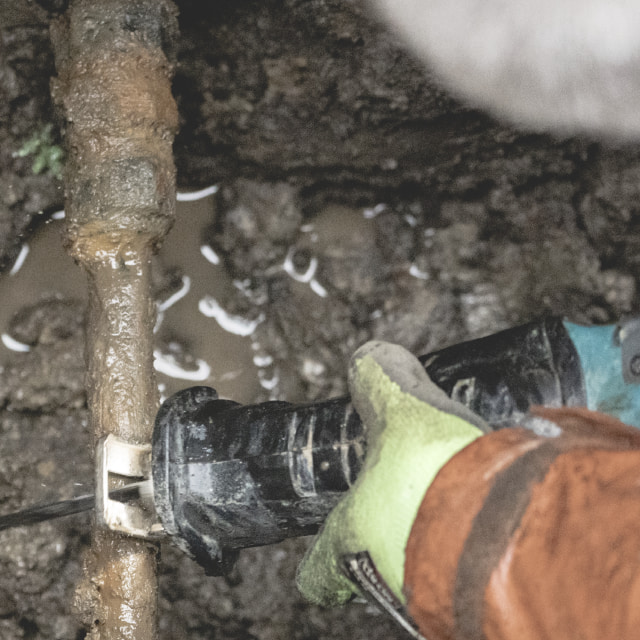
Optimised leak detection and data driven renovation
Tønder Water Utility, Denmark
With the analysis tool District Analyser, Tønder Water Utility has significantly optimised their leak detection in a particularly challenging area. New insights has allowed the utility to prioritise its use of resources and maintenance efforts. And on top of that their customers enjoy an improved service level.
When Tønder Water Utility was introduced to the analytics tool, District Analyser, the utility could quickly see the potential in relation to two of its most important focus areas: water loss and infrastructure maintenance. The tool monitors the network, and it automatically calculates daily water balances for each individual district so that the utility gets a continuous overview of the water loss.
Previously, leak localisation was particularly challenging on the island of Rømø, where the soil is very sandy – usually causing the water from leaks to disappear into the ground.
“Automation is the way forward”
Tønder Water Utility has used remotely-read meters since 2014, so they have had access a lot of data. So it was the prospect of being able to monitor the network automatically that caught the company’s interest, according to operations manager John Pies Christiansen, who says: “Our number of employees is not increasing, but we receive more and more tasks, so automation is the way forward for us.”
In the past, the utility spent a lot of time exporting data in Excel with many manual updates. With District Analyser this is done automatically. “We want a system that runs in the background and manages itself, so that we do not need to use resources until we are notified that something is wrong,” explains operations technician Christian Møller.
More effective leak detection
Previously, Tønder Water Utility only had the numbers from the pumping station to go on. If the total volume of water sent to Rømø was high compared to their experience and the historic data from the SRO system, it might indicate a leak. To localise it, the utility had to manually read and exclude one street at a time during night time, when it would cause least inconvenience. Today, the quantity that is pumped is compared automatically to the consumption in each district, making it easy to categorise the actual loss.
“With District Analyser, we go directly to leakage localisation. Before, two men could spend nine nights to track down a leak, with another week for preparatory work. Today, we can do it all in two or three days. There is a lot to save in terms of time and money,” says John Pies Christiansen. “It is about discovering where we can act most effectively – and that requires data. Driving around looking for a half cubic metre is like looking for a needle in a haystack. And it’s no good to just send in the whole cavalry.”
“With the overview we have today, we can also identify rising tendencies and be proactive,” explains Christian Møller. Among other things, this means that the supply company has improved the service it offers its customers. “Now that we have both data and knowledge, we also feel like we have a responsibility to use it to help our customers.”

Over a period, District Analyser showed a gradual increase in the water loss in one of the districts. The utility monitored the situation and found a 5m3/h leak a lot faster than what they would have normally done.
Results of remotely-read meters, frequent data and targeted data analysis




Prioritised pipe renovation
The detailed insight from District Analyser, has enabled them to prioritise their renovation based on the actual condition of the pipes rather than their age, as they previously did. ”We need to take action where our efforts can create the most value. And that is the knowledge District Analyser gives us today.” says John Pies Christiansen.
Recently, the utility decided to prioritise the renovation of one particular stretch of distribution main where District Analyser for a while had indicated a large leak in one district where the sandy soil made it almost impossible to detect by the traditional methods. The results were clear: the water loss was reduced immediately from 1.8 m3/h to 0.25 m3/h. after the renovation.
A tool to support operations
For Tønder Water Utility, District Analyser is first and foremost a service tool. Among other things, the utility is very satisfied with the interface, which makes it easy to design and update the districts, says service engineer Erling Atzen. “As a technician, I prefer to have my tools in my hands rather than on the screen, but this sure is easy.”
For example, the utility now know how to identify an open valve after the system drew their attention to something that turned out to be an open valve between two districts. “It is more fun to hunt down leaks now that it is not just based on hunches and presumptions but on actual data,” says Erling Atzen.
Tønder Water Utility is expanding their use of District Analyser to also cover the mainland, where their leak detection is also challenging due to a high number of connections.
Just as on Rømø, the goal is to create small districts and collect hourly data on the entire network, so District Analyser can be used on the entire distribution network – and the expectations are high.
Perhaps you would also be interested in…

MULTICAL® 21 / flowIQ® 210x

READy






